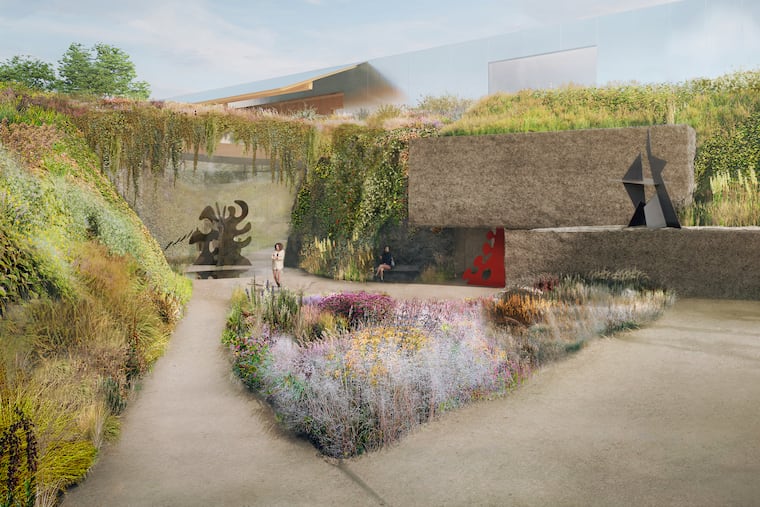Much-awaited Calder Gardens breaks ground on the Parkway
The $70 million project will house a rotating selection of Calder’s works, and is expected to be completed by late 2024.

In 1868, sculptor Alexander Milne Calder immigrated to Philadelphia and eventually created the statue of William Penn on Philadelphia City Hall’s tower. His son, sculptor Alexander Stirling Calder, met artist Nanette Lederer while studying at the Pennsylvania Academy of the Fine Arts, and they married in 1895. Their son, Alexander “Sandy” Calder, the sculptor best known for his mobiles, was born in 1898 in Lawnton, Pa.
In what can seen as a homecoming, a groundbreaking ceremony was held Tuesday to celebrate the long-awaited start to the building of Calder Gardens, a new museum dedicated to the works and ideas of the illustrious Alexander “Sandy” Calder.
Decades in the making and planning, the exhibition space will be located on the Benjamin Franklin Parkway between 21st and 22nd Streets across from the Barnes Foundation. Located on nearly two acres of land, the $70 million project is intended to be a sanctuary of gardens and art that will house a rotating selection of Calder’s iconic mobiles, stabiles (self-supporting, static sculptures), monumental sculptures, and paintings from the Calder Foundation in New York. It is expected to be completed by late 2024.
Calder Gardens will be “a way to get close to Calder,” said Alexander S. C. Rower, the artist’s grandson and president of the Calder Foundation.
Art patrons and public officials at Tuesday’s ceremony said the new museum will add to Philadelphia’s stature as a cultural destination but will also honor the Calder family’s legacy in the city.
Alexander Stirling Calder designed and created the Swann Fountain, the centerpiece of Logan Circle. Visitors to the Philadelphia Museum of Art may be familiar with his son’s Ghost mobile that graces the institution’s Great Stair Hall.
“The Calder family is integral to the history of Philadelphia and now is integral to its future,” said Mayor Jim Kenney, who was present at the groundbreaking.
Before shovels went into the ground, Urie Ridgeway and Denise Bright Dove Ashton-Dunkley of the Nanticoke Lenni-Lenape performed a land blessing of the site at the invitation of Rower.
Some might say the project’s sponsors could have used the benediction long ago. Plans for the museum stalled years ago and might not have happened if for the persistence of its champions, said speakers at the Tuesday event. “This (was) a team effort and an extraordinary milestone that all of us collectively can be proud of,” said Marsha Perelman, Calder Gardens’ board president.
A Calder museum in Philadelphia was first pitched to the Calder Foundation in the late 1990s under Mayor Ed Rendell’s administration. Despite financial support and seemingly great promise, the project ended up grinding to a halt by 2005.
The project’s champions apparently never totally gave up. High on that list was the late H.F. “Gerry” Lenfest, as well as Rower and Joe Neubauer, chairman of the Neubauer Family Foundation.
Gerry Lenfest, a former owner of The Inquirer and whose Lenfest Institute still supports the paper, spoke to Neubauer before he died and asked him about the Calder Gardens project. Lenfest, Neubauer said, told him to “just get it done.”
“It wasn’t a request,” the philanthropist quipped.
The Neubauer Family Foundation has provided lead funding to the project, which is a public-private partnership.
The exhibition space promises to be notable. Its building was designed by Herzog & de Meuron, the firm responsible for London’s Tate Modern. The gardens are being designed by acclaimed landscape architect Piet Oudolf.
And of course, the intention is to keep things fresh with regular changes in the exhibition of Calder’s work.
“We don’t want to have a mausoleum,” grandson Rower said. “We want Calder Gardens to really be alive.”